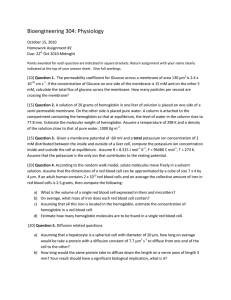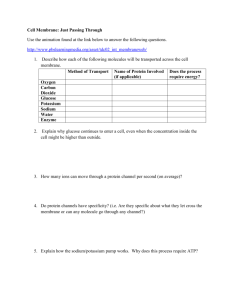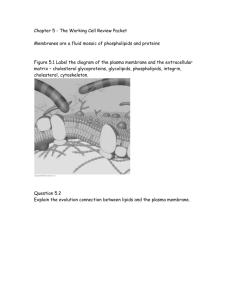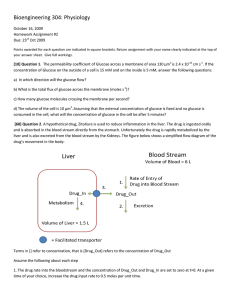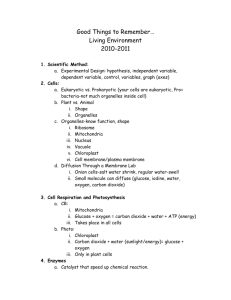Bioengineering 304: Physiology October 6, 2008 Homework Assignment #2 Due: 13
advertisement
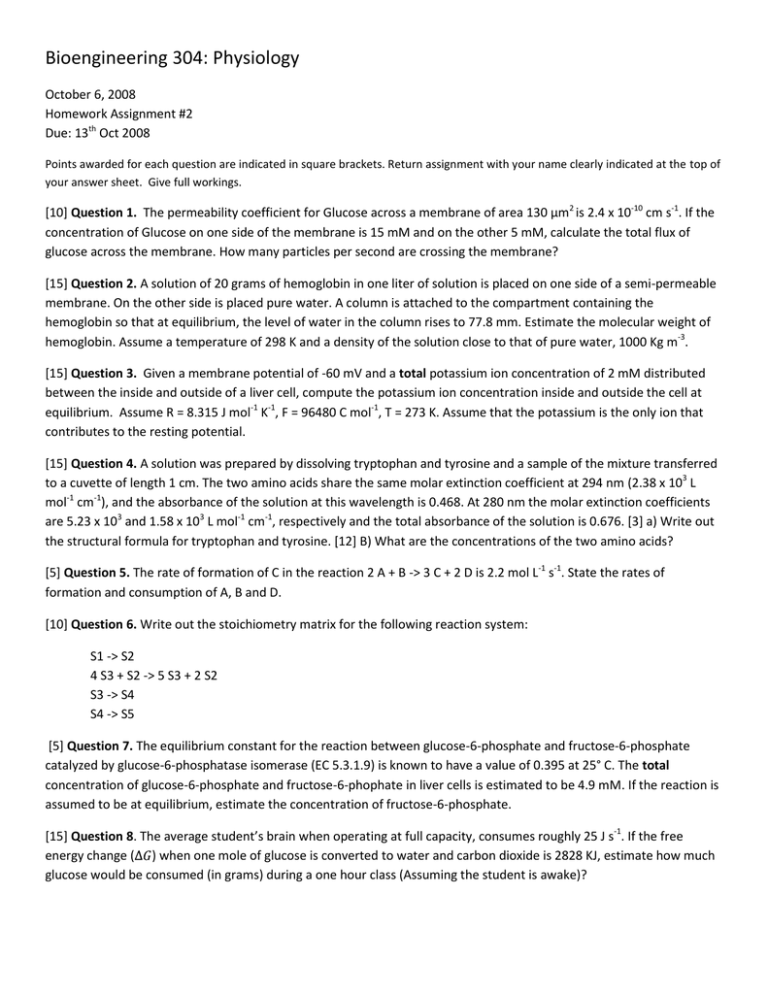
Bioengineering 304: Physiology October 6, 2008 Homework Assignment #2 Due: 13th Oct 2008 Points awarded for each question are indicated in square brackets. Return assignment with your name clearly indicated at the top of your answer sheet. Give full workings. [10] Question 1. The permeability coefficient for Glucose across a membrane of area 130 µm2 is 2.4 x 10-10 cm s-1. If the concentration of Glucose on one side of the membrane is 15 mM and on the other 5 mM, calculate the total flux of glucose across the membrane. How many particles per second are crossing the membrane? [15] Question 2. A solution of 20 grams of hemoglobin in one liter of solution is placed on one side of a semi-permeable membrane. On the other side is placed pure water. A column is attached to the compartment containing the hemoglobin so that at equilibrium, the level of water in the column rises to 77.8 mm. Estimate the molecular weight of hemoglobin. Assume a temperature of 298 K and a density of the solution close to that of pure water, 1000 Kg m-3. [15] Question 3. Given a membrane potential of -60 mV and a total potassium ion concentration of 2 mM distributed between the inside and outside of a liver cell, compute the potassium ion concentration inside and outside the cell at equilibrium. Assume R = 8.315 J mol-1 K-1, F = 96480 C mol-1, T = 273 K. Assume that the potassium is the only ion that contributes to the resting potential. [15] Question 4. A solution was prepared by dissolving tryptophan and tyrosine and a sample of the mixture transferred to a cuvette of length 1 cm. The two amino acids share the same molar extinction coefficient at 294 nm (2.38 x 103 L mol-1 cm-1), and the absorbance of the solution at this wavelength is 0.468. At 280 nm the molar extinction coefficients are 5.23 x 103 and 1.58 x 103 L mol-1 cm-1, respectively and the total absorbance of the solution is 0.676. [3] a) Write out the structural formula for tryptophan and tyrosine. [12] B) What are the concentrations of the two amino acids? [5] Question 5. The rate of formation of C in the reaction 2 A + B -> 3 C + 2 D is 2.2 mol L-1 s-1. State the rates of formation and consumption of A, B and D. [10] Question 6. Write out the stoichiometry matrix for the following reaction system: S1 -> S2 4 S3 + S2 -> 5 S3 + 2 S2 S3 -> S4 S4 -> S5 [5] Question 7. The equilibrium constant for the reaction between glucose-6-phosphate and fructose-6-phosphate catalyzed by glucose-6-phosphatase isomerase (EC 5.3.1.9) is known to have a value of 0.395 at 25° C. The total concentration of glucose-6-phosphate and fructose-6-phophate in liver cells is estimated to be 4.9 mM. If the reaction is assumed to be at equilibrium, estimate the concentration of fructose-6-phosphate. [15] Question 8. The average student’s brain when operating at full capacity, consumes roughly 25 J s-1. If the free energy change ( ) when one mole of glucose is converted to water and carbon dioxide is 2828 KJ, estimate how much glucose would be consumed (in grams) during a one hour class (Assuming the student is awake)?
